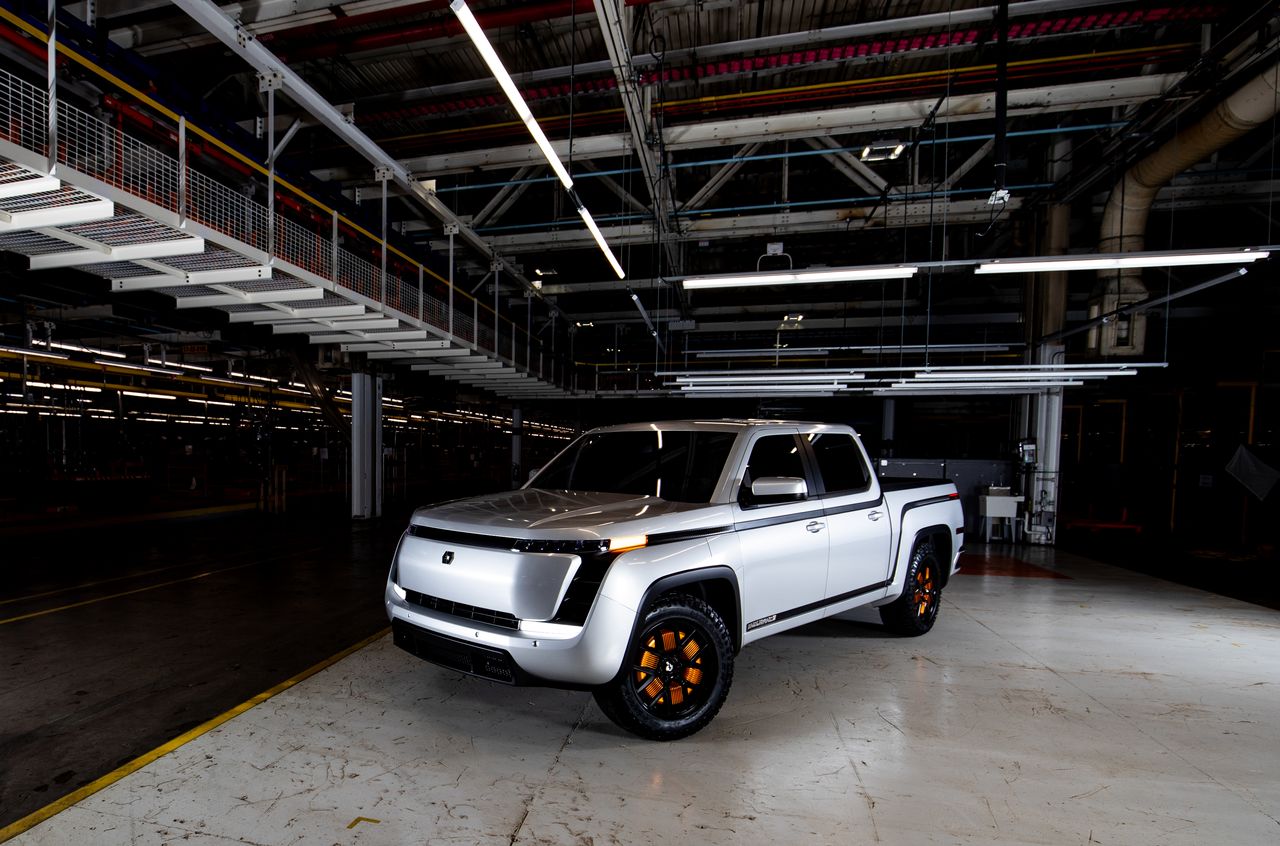Short Seller Takes Aim at Another EV Maker
Not all EVs are built the same in market.
Many new electric-vehicle start-ups have no sales and big aspirations. Electric truck maker Lordstown Motors is one of them. The company doesn’t sell EVs yet, but expects to start selling its all-electric truck called Endurance later in 2021. After the launch, Lordstown projects explosive growth off its 2021 base in 2022 and beyond.
One short seller, however, isn’t buying it.
On Friday morning, Hindenburg Research published a negative research report about Lordstown Motors (ticker: RIDE). The report makes several claims, notably that not all of the preorders the company has claimed are real.
The report is hitting the stock. Shares are down 20%, at $14.18, in Friday morning trading. The S&P 500, by comparison, is down 0.5%. The Dow Jones Industrial Average is up 0.5%.
On Jan. 11, Lordstown reported more than 100,000 preorders for its Endurance pickup truck launched this past summer. Hindenburg claims in its report that it has talked to some Lordstown preorder customers, and points out some it found that don’t have the cash to buy ordered trucks and that preorders don’t carry a commitment to purchase or a penalty to cancel.
Lordstown wasn’t immediately available to comment on the Hindenburg report.
Preorders in the EV industry are fairly common. Tesla (TSLA), when it launched its Cybertruck, regularly reported preorders. Tesla racked up hundreds of thousands in vehicle preorders before it stopped reporting the number. A Cybertruck could be reserved for US$100, which is fully refundable.
Hindenburg is the firm that published a negative research report about electric- and hydrogen-powered trucking company Nikola (NKLA) back in September 2020. Hindenburg alleged Nikola management misled investors. Nikola denied the claims. The report, however, led to the departure of company founder Trevor Milton.
An internal investigation conducted by an outside firm at the behest of Nikola followed and, as a result, the company disclosed in its annual report nine statements made by Miltion which may have been partially untrue.
At the time of the report, Hindenburg was short Nikola stock, betting that its price would decline. Now, Hindenburg is short Lordstown stock and stands to gain as it falls.
Lordstown became a publicly traded company in 2020 after merging with a special purpose acquisition company. The company, founded by Steve Burns, purchased an Ohio plant from General Motors (GM) to kick-start its growth plants.
The company projects more than $100 million in sales for 2021, growing to $1.7 billion in sales in 2022 and then to $5.8 billion by 2024. Vehicle deliveries over that span are projected to go from 2,200 in 2021 to more than 100,000 in 2024.
Lordstown will report fourth-quarter results on March 17 after the market closes. Investors and analysts will have a chance to hear from management then.
 Copyright 2020, Dow Jones & Company, Inc. All Rights Reserved Worldwide. LEARN MORE
Copyright 2020, Dow Jones & Company, Inc. All Rights Reserved Worldwide. LEARN MORE
This stylish family home combines a classic palette and finishes with a flexible floorplan
Just 55 minutes from Sydney, make this your creative getaway located in the majestic Hawkesbury region.
Impact investing is becoming more mainstream as larger, institutional asset owners drive more money into the sector, according to the nonprofit Global Impact Investing Network in New York.
In the GIIN’s State of the Market 2024 report, published late last month, researchers found that assets allocated to impact-investing strategies by repeat survey responders grew by a compound annual growth rate (CAGR) of 14% over the last five years.
These 71 responders to both the 2019 and 2024 surveys saw their total impact assets under management grow to US$249 billion this year from US$129 billion five years ago.
Medium- and large-size investors were largely responsible for the strong impact returns: Medium-size investors posted a median CAGR of 11% a year over the five-year period, and large-size investors posted a median CAGR of 14% a year.
Interestingly, the CAGR of assets held by small investors dropped by a median of 14% a year.
“When we drill down behind the compound annual growth of the assets that are being allocated to impact investing, it’s largely those larger investors that are actually driving it,” says Dean Hand, the GIIN’s chief research officer.
Overall, the GIIN surveyed 305 investors with a combined US$490 billion under management from 39 countries. Nearly three-quarters of the responders were investment managers, while 10% were foundations, and 3% were family offices. Development finance institutions, institutional asset owners, and companies represented most of the rest.
The majority of impact strategies are executed through private-equity, but public debt and equity have been the fastest-growing asset classes over the past five years, the report said. Public debt is growing at a CAGR of 32%, and public equity is growing at a CAGR of 19%. That compares to a CAGR of 17% for private equity and 7% for private debt.
According to the GIIN, the rise in public impact assets is being driven by larger investors, likely institutions.
Private equity has traditionally served as an ideal way to execute impact strategies, as it allows investors to select vehicles specifically designed to create a positive social or environmental impact by, for example, providing loans to smallholder farmers in Africa or by supporting fledging renewable energy technologies.
Future Returns: Preqin expects managers to rely on family offices, private banks, and individual investors for growth in the next six years
But today, institutional investors are looking across their portfolios—encompassing both private and public assets—to achieve their impact goals.
“Institutional asset owners are saying, ‘In the interests of our ultimate beneficiaries, we probably need to start driving these strategies across our assets,’” Hand says. Instead of carving out a dedicated impact strategy, these investors are taking “a holistic portfolio approach.”
An institutional manager may want to address issues such as climate change, healthcare costs, and local economic growth so it can support a better quality of life for its beneficiaries.
To achieve these goals, the manager could invest across a range of private debt, private equity, and real estate.
But the public markets offer opportunities, too. Using public debt, a manager could, for example, invest in green bonds, regional bank bonds, or healthcare social bonds. In public equity, it could invest in green-power storage technologies, minority-focused real-estate trusts, and in pharmaceutical and medical-care company stocks with the aim of influencing them to lower the costs of care, according to an example the GIIN lays out in a separate report on institutional strategies.
Influencing companies to act in the best interests of society and the environment is increasingly being done through such shareholder advocacy, either directly through ownership in individual stocks or through fund vehicles.
“They’re trying to move their portfolio companies to actually solving some of the challenges that exist,” Hand says.
Although the rate of growth in public strategies for impact is brisk, among survey respondents investments in public debt totaled only 12% of assets and just 7% in public equity. Private equity, however, grabs 43% of these investors’ assets.
Within private equity, Hand also discerns more evidence of maturity in the impact sector. That’s because more impact-oriented asset owners invest in mature and growth-stage companies, which are favored by larger asset owners that have more substantial assets to put to work.
The GIIN State of the Market report also found that impact asset owners are largely happy with both the financial performance and impact results of their holdings.
About three-quarters of those surveyed were seeking risk-adjusted, market-rate returns, although foundations were an exception as 68% sought below-market returns, the report said. Overall, 86% reported their investments were performing in line or above their expectations—even when their targets were not met—and 90% said the same for their impact returns.
Private-equity posted the strongest results, returning 17% on average, although that was less than the 19% targeted return. By contrast, public equity returned 11%, above a 10% target.
The fact some asset classes over performed and others underperformed, shows that “normal economic forces are at play in the market,” Hand says.
Although investors are satisfied with their impact performance, they are still dealing with a fragmented approach for measuring it, the report said. “Despite this, over two-thirds of investors are incorporating impact criteria into their investment governance documents, signalling a significant shift toward formalising impact considerations in decision-making processes,” it said.
Also, more investors are getting third-party verification of their results, which strengthens their accountability in the market.
“The satisfaction with performance is nice to see,” Hand says. “But we do need to see more about what’s happening in terms of investors being able to actually track both the impact performance in real terms as well as the financial performance in real terms.”
This stylish family home combines a classic palette and finishes with a flexible floorplan
Just 55 minutes from Sydney, make this your creative getaway located in the majestic Hawkesbury region.






















